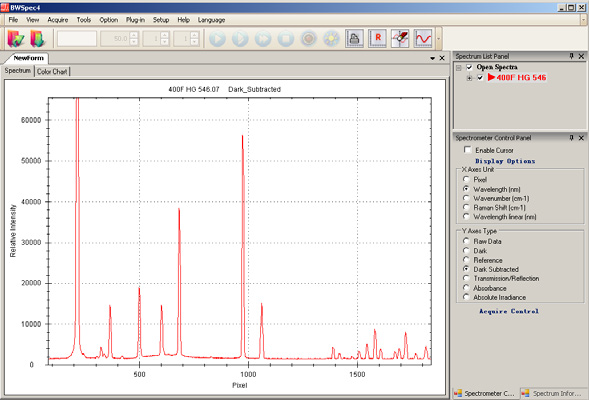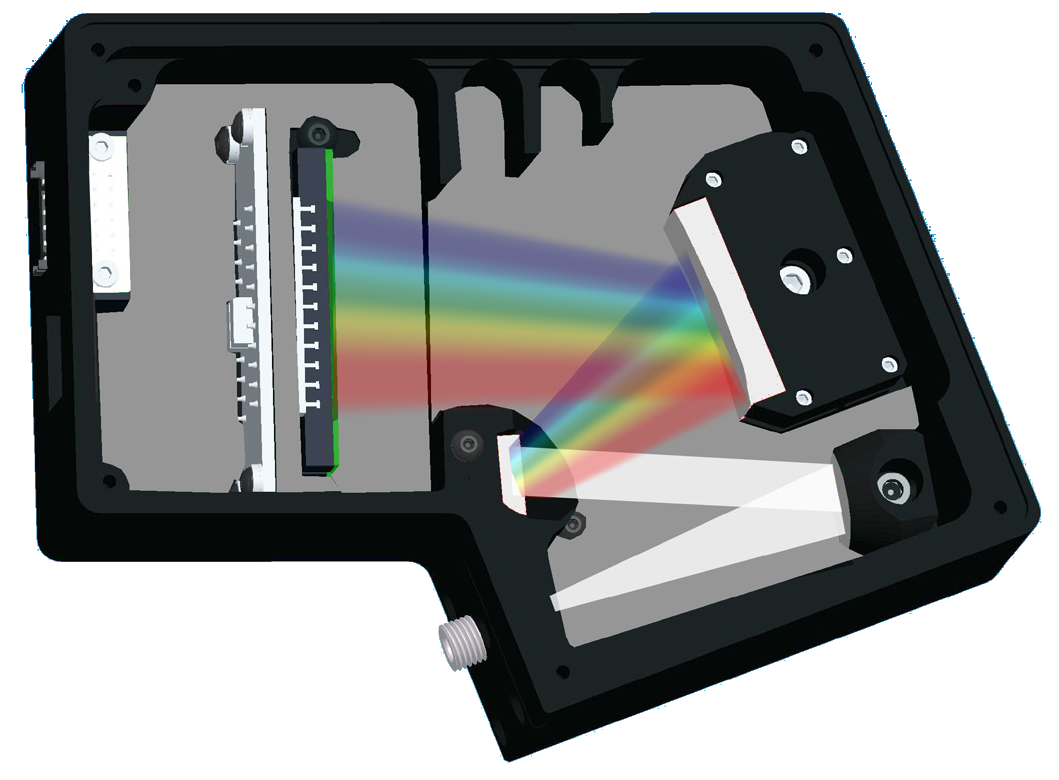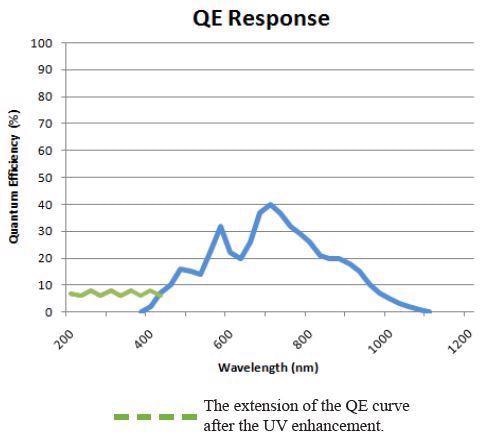Quest™ U—a linear CCD array spectrometer from B&W Tek—has been improved for UV performance through a low stray light optical bench.
The spectrometer features an integrated 16-bit digitizer, a 2048 element detector, an external trigger and a USB 2.0 interface with a readout speed of more than 2.0 MHz. The temperature-compensated Quest™ U considerably decreases the thermal drift to approximately 15 counts/°C. This provides better stability by reducing the baseline drift and maintaining the dynamic range.
The Quest™ U spectrometer comes in two regular spectral configurations: 200–850 nm and 200–400 nm. For OEM applications, customized configurations and the RS232 communication interface are also provided. The Quest™ U spectrometer is a crucial building block for complete solutions. For OEM applications, system development and application support are also provided.
Applications
- Reflectance
- Absorbance
- Wavelength identification
- NIR UV and Vis spectroscopy/spectrophotometry/spectroradiometry
- OEM optical instrumentation component
Features
- UV and UV/NIR standard
- Low stray UV Light
- Plug-and-play USB 2.0
- A 16-bit digitizer
- A spectral resolution of more than 0.4 nm
- A minimum integration time of 1 ms
- Readout speed is more than 2.0 MHz
Accessories
- Fiber-optic probes
- Fiber patch cords
- Inline filter holders
- Cuvette holders
- Light sources
Software
The BWSpec® spectral data acquisition software has been developed to carry out complex calculations and measurements at the touch of a button. With the help of this software, users can select between numerous data formats and optimize scanning parameters, including the integration time.
Apart from robust data processing and data acquisition, other features of the BWSpec® include spectrum smoothing, automatic dark removal and manual/automatic baseline correction.

Image Credit: B&W Tek
Specifications
Table 1. Source: B&W Tek
| . |
. |
| Power Input |
USB @ < 0.35 Amps |
| Detector Type |
Response-Enhanced Linear CCD Array |
| Detector Pixel Format |
2048 x 1 Elements @ 14 µm x 200 µm Per Element |
| Spectrograph f/# |
3.6 |
| Spectrograph Optical Layout |
Czerny-Turner |
| Dynamic Range |
1300:1 Single Acquisition |
| Digitizer Resolution |
16-bit or 65,535:1 |
| Readout Speed |
>2.0 MHz |
| Data Transfer Speed |
Up to 480 Spectra Per Second Via USB 2.0 |
| Integration Time |
1 - 65,535 ms |
| Thermal Drift |
~15 Counts/oC (~29 Counts/oC Max) |
| Aux Port |
External Trigger, Digital IOs |
| Operating Temperature |
5 °C - 35 °C |
| Operational Relative Humidity |
85% Noncondensing |
| Weight |
~ 0.8 lbs (0.37 kg) |
| Dimensions |
4.9 in x 3.6 in x 1.4 in (124 mm x 91 mm x 35 mm) |
| Computer Interface |
USB 2.0 / 1.1 and Enhanced RS232 |
| Operating Systems |
Windows: XP, 7, 8, 10 (32-bit & 64-bit) |
Technical Details of Quest™ U

Image Credit: B&W Tek
1. Fiber Coupler
Secures Fiber to Ensure Repeatable Results
When a fiber optic is coupled to the SMA 905 adaptor, light is directed to the slit and optically matched, guaranteeing reproducibility. A lens or diffuser assembly can be directly linked to the SMA 905 adaptor for free-space sampling.
2. Entrance Slit
Determines Photon Flux and Spectral Resolution
Light penetrating the optical bench of a spectrometer is vignetted by an aligned, pre-mounted slit. This eventually establishes the throughput and spectral resolution of the spectrometer after the selection of gratings. B&W Tek provides an array of slit widths to match the specific application requirements of users. Custom slits are also available.
Table 2. Source: B&W Tek
Slit
Option |
Dimensions |
Approx. Resolution
200-400 nm |
Approx. Resolution
200-850 nm |
| 10 µm |
10 µm wide x 1 mm high |
~0.4 nm |
~1.0 nm |
| 25 µm |
25 µm wide x 1 mm high |
~0.6 nm |
~1.5 nm |
| 50 µm |
50 µm wide x 1 mm high |
~1.0 nm |
~2.5 nm |
| 100 µm |
100 µm wide x 1 mm high |
~1.6 nm |
~4 nm |
| 200 µm |
200 µm wide x 1 mm high |
~3.0 nm |
~8 nm |
| Custom Slit Widths Available |
3. Collimating Mirror
Collimates and Redirects Light Towards Grating
Both the collimating mirrors are f/# matched and coated with AlMg2, which creates a reflectance of about 95% when operating in the UV-Vis spectrum. While aluminum (Al) offers reflectance, magnesium (Mg2) protects the former from oxidation.
4. Diffraction Grating
Diffracts Light, Separating Spectral Components
The groove frequency of the grating governs two major aspects of the performance of the spectrometer—the spectral resolution and the wavelength coverage.
Upon increasing the groove frequency, the instrument will acquire a higher resolution, but at the same time, the wavelength coverage will also reduce. Inversely, when the groove frequency is decreased, the wavelength coverage increases, thereby affecting the spectral resolution.
The blaze wavelength or blaze angle of the grating is a major parameter for improving the performance of the spectrometer. The blaze angle decides the highest efficiency exhibited by the grating in a particular wavelength region.
Table 3. Source: B&W Tek
| Best Efficiency |
Spectral Coverage (nm) |
Grating |
| UV |
200 - 400 |
1800/250 |
| UV - NIR |
200 - 850 |
600/250 |
| Custom Configurations Available |
5. Focusing Mirror
Refocuses Dispersed Light onto Detector
Both are f/# matched focusing mirrors coated with AlMg2, which generates a reflectance of about 95% when operating in the UV-Vis spectrum. Aluminum (Al) offers reflectance, while magnesium (Mg2) protects the former from oxidation.
6. Array Detector
Measures Entire Spectrum Simultaneously
The Quest™ U includes a 2048 x 1 linear CCD array detector with a pixel width of 14 µm and more than 2000 active pixels. When the incident light hits the individual pixels over the CCD, every pixel denotes a part of the spectrum that, in turn, is translated and displayed by the electronics with a specified intensity using the BWSpec® software.
The noise level and quantum efficiency (QE) of the array detector considerably affects the dynamic range, sensitivity and signal-to-noise ratio of the spectrometer. The spectral acquisition rate of the spectrometer is chiefly governed by the detector response across a wavelength region.
Table 4. Source: B&W Tek
| Specifications |
| Wavelength Range |
200 nm - 850 nm |
| Pixels |
2048 |
| Pixel Size |
14 µm x 200 µm |
| Well Depth |
~65,000 e |
| Digitization Rate |
>2.0 MHz |
